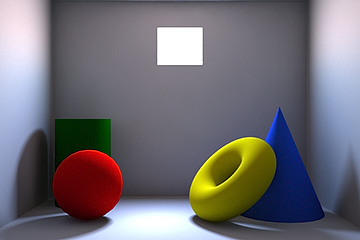Portals are not lights in the traditional sense, as they produce no illumination by themselves. They are meant more to control lighting, especially that of interior renders that rely mainly on Global Illumination. Think of them as gathering rays and focusing them into a specific area. In this following example, the interior is illuminated solely by the environment, no lights are being used whatsoever. At the default settings, the image on the left exhibits some chattering and splotches, especially in the area of shadow transitions. In the second image on the right, a Portal has been added to the scene and set with 512 light samples. This produces a much smoother result with no other setting or value changes.
|
|
|
The main use for 'Portals' is not surprisingly to be placed at openings; anywhere light would enter into an interior, such as a window, door or skylight. For best results users should position the portal directly outside the portal itself (or inside depending on the shape of the opening) and scale it to be slightly larger than opening. Users can also adjust the shape of the portal to better represent the shape of the window, either as round or rectangular. Users should also note it is better to use fewer Portals than more, as this can add significantly to render calculation times, for example when representing a multi-paned window, using a single Portal scaled to the over-all window size would be better than individual Portals for each pane. Users should also note that Portals take their color from the environment behind them and therefor have no Light Material setting, like those of other direct light sources.
Portal
 Name: This data field displays the current item name. Users may easily change it by LMB-clicking within the field and typing the new name.
Name: This data field displays the current item name. Users may easily change it by LMB-clicking within the field and typing the new name.
Transform--
Position: An Item transform that allows the user to numerically position the Portal item in XYZ space. By default, Position transforms originates from the items center position.
Rotation: An Item transform that allows the user to numerically set the rotation of the Portal item. By default, Rotation transforms originates from items center position.
Order: Allows the user to set the order that rotations are applied to the Portal item. Changing the order that rotations are applied can sometimes help to reduce or eliminate gimbal lock when animating.
Scale: An Item transform that allows the user to numerically set the scale of the item. By default, Scale transforms originate from the Center position.
Reset: Resets the selected transform values to (0,0,0) returning the items back to the world space center position.
Zero: Returns the Portal items Center position to the world space center (0,0,0) without changing the position of the Portal item itself. This is done by the addition of a negative transform added to the Transform channels.
Add: The 'Add' function will add the selected set of transforms to the channel list. Useful when animating complex motions, providing a layered approach to the transforms.
Portal--
Render: This drop down menu allows the user to select from 3 choices, when set to 'Default', the user can enable/disable Portals using the visibility function "![]() " of the item list. When the Portal is visible, it contributes to the final rendered scene and when invisible, it will not. On some instances the user may prefer to fix this state, setting the Portal as 'On' (enabled) or 'Off' (disabled) regardless of visibility. Also useful for workflows that auto toggle visibility, saving the user from manually enabling Portals for test renders.
" of the item list. When the Portal is visible, it contributes to the final rendered scene and when invisible, it will not. On some instances the user may prefer to fix this state, setting the Portal as 'On' (enabled) or 'Off' (disabled) regardless of visibility. Also useful for workflows that auto toggle visibility, saving the user from manually enabling Portals for test renders.
Shape: This option determines the final shape of the Portal, set as either Rectangular or Elliptical. User can then adjust the 'Width' and 'Height' options to further define square, rectangular, circular or oval type shapes.
Width/Height: This value determines the actual size of the Portal. Users should size the Portal to approximate the overall size of the window it is representing.
Samples: This value determines the Portals light gathering ability, having greater numbers of Samples will increase the overall accuracy of the final rendered image, but also keep in mind that additional rays will also adversely affect render times, so users should adjust the rays to find a balance of quality versus render time.




